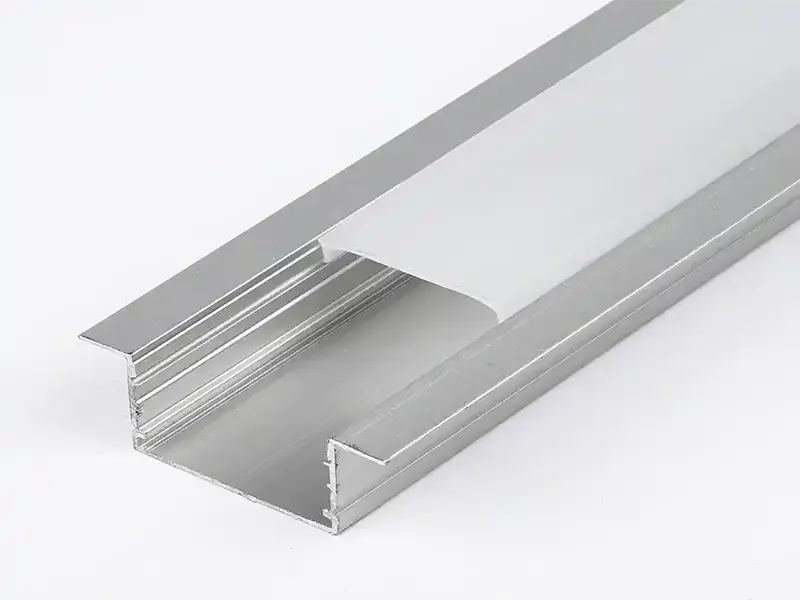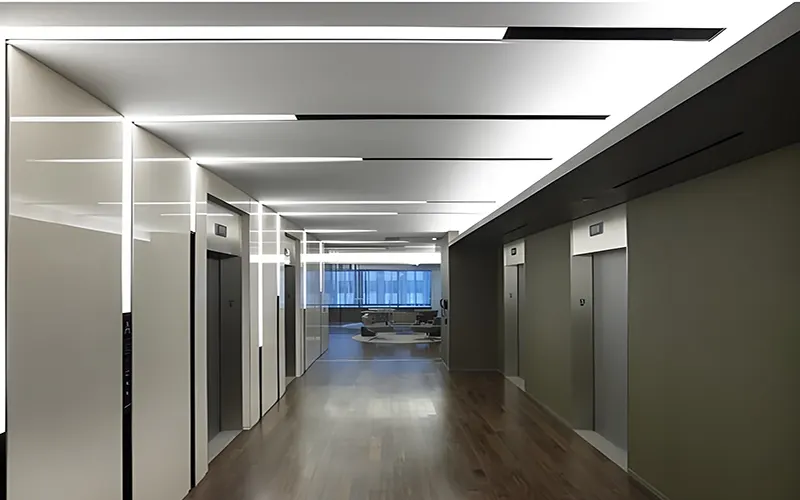In modern lighting design, we often see two common choices: LED aluminum profiles and COB LED light strips. Most people compare the two. In fact, both have their advantages and different uses, and both can perform excellently in various application scenarios. Next, we will discuss LED Aluminum Profiles vs. COB LED Strips.
What is An LED Aluminum Profile?
LED aluminum profiles are channels or housings used to secure and protect LED light strips. These profiles not only enhance the aesthetics of the lighting but also improve heat dissipation, extending the lifespan of the LED light strips. More details, pls read LED Aluminum Channel Complete Guide 2024

LED profiles are available in various shapes and sizes, and with different installation methods, including pendant LED profiles, surface-mount LED profiles, and bent LED profiles.
They are typically made of high-quality aluminum and offer different surface finishes such as black, frosted, clear, or milky white to achieve uniform light diffusion.
LED profiles are widely used in architectural and interior lighting. They give lighting systems a stylish and modern look while maintaining the optimal performance of LED light strips.
What is a COB LED strip?
A COB LED strip is an advanced technology and an innovation in lighting products. It tightly encapsulates multiple LED chips onto a single circuit board without any visible gaps.
This results in a seamless effect, avoiding the “dot-like” light spots common in traditional SMD (Surface Mount Device) LED strips. It can achieve up to 480 LEDs per meter or even more, and COB strips are renowned for their uniform light and higher lumen output.
COB LED strips are widely used in applications requiring extremely high light quality and consistency, such as commercial lighting and high-end architectural projects.

LED Aluminum Profiles vs. COB LED Strips: Which is Better for Your Lighting Project?
Light Quality Difference
When comparing LED Aluminum Profiles vs. COB LED Strips, a comprehensive analysis is necessary. COB LED strips have a significant advantage in this regard because they provide continuous and seamless light output. The high-density arrangement of chips eliminates dark spots, resulting in smoother, more aesthetically pleasing light.
On the other hand, traditional LED strips installed within aluminum profiles may exhibit individual LED “spots,” depending on the profile depth and diffuser type, making the selection of a suitable LED aluminum profile crucial.
While LED profiles also offer light-diffusion options, they may not achieve the same level of smoothness as COB strips, especially in projects requiring ultra-smooth lighting.
Heat Management
Although LED lighting products don’t generate much heat, heat dissipation is still an important consideration. Thermal management is crucial for extending the lifespan of LED lights and improving their performance. More, pls check Why Does the LED Strip need the LED Profile?
LED aluminum profiles are specially designed to act as heat sinks, dissipating heat from the LED strips and preventing overheating. This feature is especially important in high-power applications, as it ensures stable performance and protects your investment.
While COB LED strips offer high brightness, they tend to generate more heat because the LED chips are concentrated in a very small area. Combining them with aluminum profiles can significantly improve their heat dissipation efficiency. For long-term use, integrated systems combining COB strips with aluminum profiles offer the advantages of both.
Installation and Flexibility
COB LED strips offer advantages in installation and flexibility. Their flexibility allows them to easily navigate corners and be installed in confined spaces, making them ideal for complex or curved installations.
This makes COB strips ideal for creative lighting designs, especially in locations where traditional aluminum profiles are difficult to install.
While LED aluminum profiles offer a clean and professional look. Their rigid structure can be limiting in certain installation scenarios, such as narrow spaces. Aluminum profiles are best suited for straight-line installations or applications requiring robust enclosure protection. However, in prominent areas, aluminum profiles offer a more refined appearance and are easier to maintain over the long term.
Durability and Protection
In terms of durability and protection, aluminum LED profiles have an advantage over COB LED strips. The aluminum housing effectively protects against dust, moisture, and physical damage, which is especially important for outdoor or exposed environments.
Furthermore, the aluminum profile enhances the luminaire’s resistance to environmental factors, protecting the non-waterproof LED strips and extending their lifespan.
While COB LED strips are durable, they are more susceptible to physical damage without additional protection. However, some COB strips come with a silicone protective coating, which further enhances durability in certain applications. Particularly indoors where exposure to harsher environments is less likely.
Aesthetics
From an aesthetic perspective, both LED aluminum profiles and COB LED light strips have their advantages. COB LED light strips offer a modern and seamless lighting effect, avoiding the “spot” phenomenon of traditional light strips. Making them ideal for high-end visible applications.
On the other hand, LED aluminum profiles present a structured and sophisticated appearance, cleverly concealing LED light strips and offering a variety of diffuser options. Therefore, from an aesthetic point of view, LED profiles are a good choice.
Additionally, if you desire a professional and sophisticated look for your lighting installation. Especially in commercial spaces or high-traffic areas, aluminum profiles are undoubtedly the ideal choice.
Choosing the Right Option for Your Project
Ultimately, the choice between LED Aluminum Profiles vs. COB LED Strips depends on your specific project requirements. If you prioritize high quality, seamless lighting, and minimal visual interference, then COB LED strips are undoubtedly the best choice.
However, if you need a durable solution with good heat dissipation that provides both protection and a clean, sophisticated look, then a combination of LED aluminum profiles and traditional LED strips may be a better option.
In short, aluminum profiles are also well-suited for installation environments requiring physical protection for LED strips, especially outdoors or in high-traffic areas.
Conclusion
LED Aluminum Profiles vs. COB LED Strips each have their advantages depending on the application scenario. COB LED strips are known for their high-quality light, making them ideal for high-end lighting designs. LED aluminum profiles, on the other hand, offer excellent protection, heat dissipation, and professional-grade surface treatment, making them ideal for architectural lighting.
If you need more LED profiles, such as curved LED profiles or black LED profiles, please contact us.




